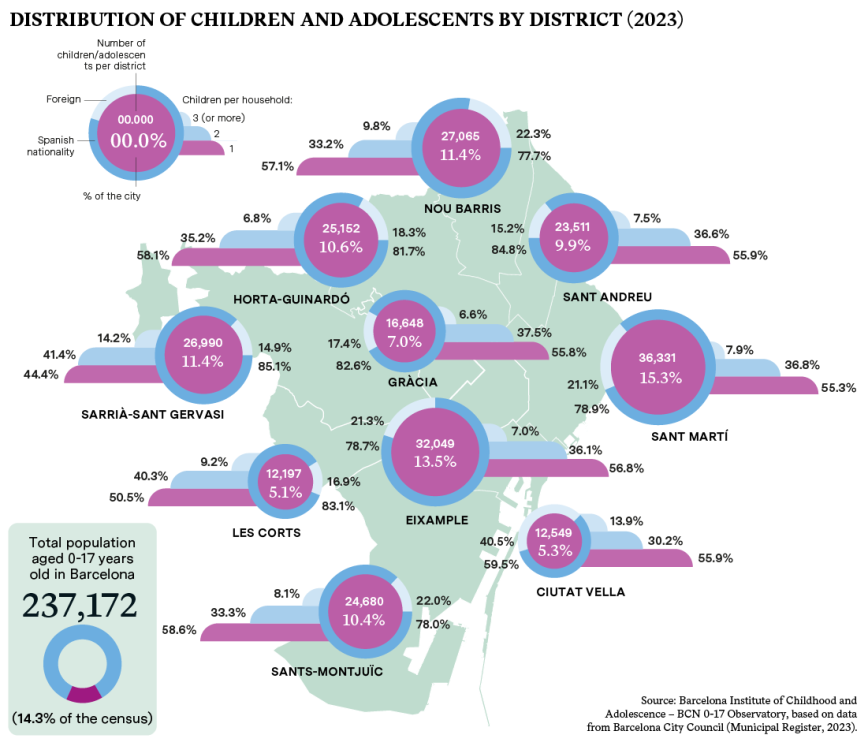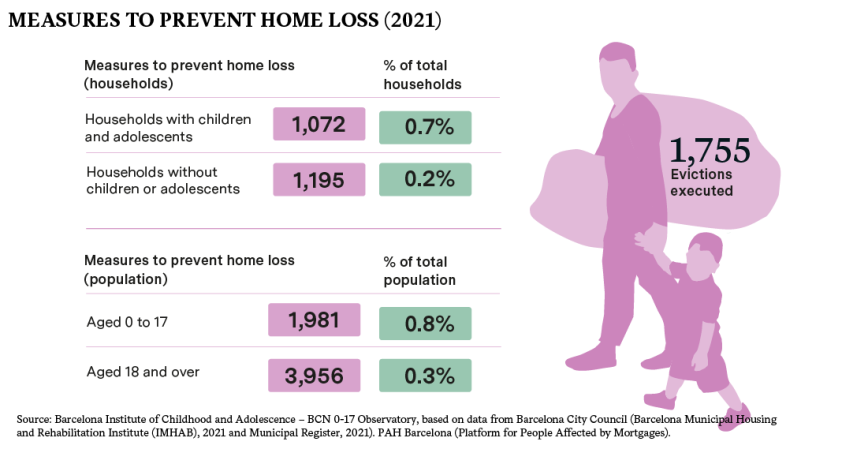Impact of poverty and inequality on childhood and adolescence
- Open data
- Apr 24
- 4 mins
Oriol Pàmies, texts / Carles Javierre Kohan, infographics
Children aren’t just the future of a city; they are also part of the present, despite their relatively small demographic representation. In Barcelona, children account for approximately 14% of the population, but this figure rises to 38% if adults living with them are taken into account. A closer examination of the data reveals how growing social disparities particularly impact families with children. Consequently, the repercussions of poverty and economic hardship on the population aged 0 to 17 pose a significant risk to future social cohesion. This presents a major challenge for public policies aimed at preventing vulnerabilities and promoting equity.


The role of the environment
The territorial context and social conditions within children’s environments play a pivotal role in shaping inequalities. Three out of ten children and adolescents in the city grow up in neighbourhoods with a very high or high urban vulnerability index, while one out of ten resides in areas with a medium index. Six out of ten children inhabit neighbourhoods with a low or very low vulnerability index. The highest vulnerability indices are concentrated in neighbourhoods within the districts of Ciutat Vella, Sants-Montjuïc, Horta-Guinardó, Nou Barris, Sant Andreu and Sant Martí.

A breather after the health crisis
Three out of ten children and adolescents in the city are at risk of poverty and/or social exclusion according to the AROPE rate. This European indicator considers not only income levels but also factors such as low work intensity among adults living with children and difficulties in accessing basic material goods. The trend in this indicator shows improvement compared to data from 2020-2021, during the peak of the pandemic. However, it is evident that children, adolescents and households with them are still at a higher risk of poverty and/or exclusion than the general population or other types of households.
Drop in severe and moderate poverty
When it comes to monetary poverty, 28% of children and adolescents in Barcelona live with incomes below the moderate poverty threshold, while 12.9% live below the severe poverty threshold. The figures for the 2021-2022 period are notably lower than those recorded at the peak of the COVID-19 pandemic. Nevertheless, the rates of moderate and severe poverty risk remain higher among children and adolescents than among the total population.

Housing concerns
Two out of every ten children and adolescents in the city reside in households grappling with excessive housing expenses. Similarly, an equivalent proportion has faced delays in rent or mortgage payments, with a significant number unable to maintain their living space at an appropriate temperature. All three issues are set to worsen.

Risk of eviction
In the face of the eviction crisis, families with children or adolescents are over three times more likely to be at risk of losing their homes compared to households without children or adolescents. Ciutat Vella, Nou Barris, Sants-Montjuïc and Sant Martí are the districts with the highest number of measures aimed at preventing home loss.


Not entitled to holidays
Several indicators of severe material and social deprivation among children and adolescents have worsened over the past five years in Barcelona: one-quarter of families with children cannot afford to take a week-long holiday, one in four are unable to cover unforeseen expenses at home, and 22.6% report experiencing cold during the winter. However, the proportion of households without a computer and/or internet connection at home, essential for many school assignments, is declining.

Adults without resources
In the districts of Nou Barris, Sant Andreu and Ciutat Vella, a larger proportion of households acknowledge their inability to meet the material needs of the minors they live with. In households with very low incomes, this figure can reach 11.5%.

Ensuring school meals
Two out of ten children and adolescents in nursery, primary and secondary schools in Barcelona receive school meal grants, with an upward trend since the 2014-2015 academic year. Ciutat Vella, Nou Barris and Sants-Montjuïc are the districts that benefit the most from these grants.

Ineffective poverty alleviation policies
Public social policies show less effectiveness in the 0-17 age group compared to other age groups: they only reduce the moderate poverty rate by 7.8% and the severe poverty rate by 8.2%. This is a widespread phenomenon across the entire country.
The newsletter
Subscribe to our newsletter to keep up to date with Barcelona Metròpolis' new developments




